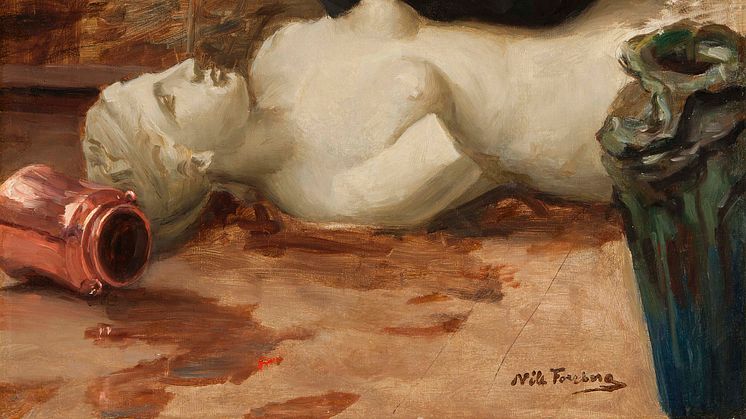
Press release -
New acquisition: Studio Interior by Nils Forsberg
Nationalmuseum has acquired a painting by Nils Forsberg. The subject is
an unusual one for this artist: a studio scene featuring his own son. In the
foreground we can glimpse a green urn, believed to be identical to the urn by Nils
Barck that is now in the museum’s collection.
Nationalmuseum has added an unusual studio scene by Nils Forsberg (1842–1934) to its painting collection. The subject is a young painter, the artist’s son and namesake, sitting in front of an easel using an upside-down sculpture as a platform. Forsberg’s painting follows a long tradition of self-portraits and depictions of artists that vacillate between conceit and reflection in the face of death. The painting has also been interpreted as a contribution to the contemporary criticism of the Royal Swedish Academy of Fine Arts in Stockholm.
Nils Forsberg led a dramatic life. After running away from home and taking an apprenticeship with a painter in Helsingborg, he attended the college in Gothenburg run by the Swedish Society of Industrial Design. In 1867 he arrived in Paris, and he did not return to Sweden until the early 1900s. In Paris, Forsberg studied under Léon Bonnat, one of the greatest French painters of the time. During the Franco-Prussian War, he enlisted as a medical orderly. His war experiences inspired his most successful work, A Hero’s Death, which is now in Nationalmuseum’s collection. This large-scale painting won the gold medal at the 1888 Paris Salon.
Nationalmuseum’s latest acquisition is entirely different in character. It is painted on a relatively small canvas using fairly simple techniques. It has been interpreted as a veiled criticism of traditional fine arts education in the late 19th century, as offered by institutions such as the Royal Swedish Academy of Fine Arts in Stockholm. The young man, taken to be the artist’s son, Nils Forsberg junior, is sitting ostentatiously on a plaster replica of one of classical antiquity’s best-known artworks, the Venus de Milo. The sculpture may represent the values that the art academies stood for, while the artist’s son embodies the future.
Forsberg’s studio interior is at once simple and ingenious in its composition, with two intersecting diagonals. One begins at the subject’s skull and ends at a large vase. The other unites the young artist with the sculpture. The same objects also delineate different levels in the space, pointing in different directions.
The green urn in the foreground not only serves as a repoussoir to add depth to the image, but may also symbolize a new era. It is believed to be identical to a unique ceramic artifact, now in Nationalmuseum’s collection (NMK 30/2005), by the Swedish artist Count Nils Barck (1863–1930). Like Forsberg, Barck lived in Paris and was noted for his innovative work with glazes. The urn, produced at the turn of the 20th century, is a clue that the painting must have been produced around the same time. This late dating means that Forsberg’s painting cannot be seen primarily as a contribution to the anti-establishment movement of the 1880s, but rather as a taunting, unconventional portrait of the artist’s son.
Nationalmuseum’s purchase has been made possible by means from Magda and Max Ettler Fund. Nationalmuseum has no budget of its own for new acquisitions, but relies on gifting and financial support from private funds and foundations to enhance its collections of fine art and craft.
Further information
Carl-Johan Olsson, curator, carl-johan.olsson@nationalmuseum.se, +46 8 5195 4324
Hanna Tottmar, press officer, hanna.tottmar@nationalmuseum.se, +46 767 23 46 32
Caption
Nils Forsberg, Studio Interior with the Artist’s Son. Photo:
Cecilia Heisser/Nationalmuseum.
Categories
Nationalmuseum is Sweden’s premier museum of art and design. The collections comprise older paintings, sculpture, drawings and graphic art, and applied art and design up to the present day. The museum building is currently under renovation and scheduled to open again in 2017. In the meantime, the museum will continue its activities through collaborations, touring exhibitions and a temporary venue at the Royal Swedish Academy of Fine Arts, Fredsgatan 12, Stockholm. Nationalmuseum collaborates with Svenska Dagbladet, Fältman & Malmén and Grand Hôtel Stockholm. For more information visit www.nationalmuseum.se.

